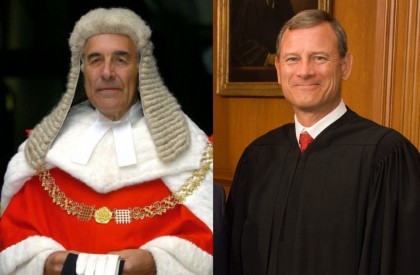Polyester Robes
Jules van Schaijik | Feb 10, 2017 | 2 cmts
In a lecture given several years ago, Neil Gorsuch, President Trump’s Supreme Court nominee, reflects on the meaning of the black robes that judges in America typically wear.
As my daughters remind me, donning a robe doesn't make me any smarter. But the robe does mean something — and not just that I can hide coffee stains on my shirt. It serves as a reminder of what's expected of us — what Burke called the “cold neutrality of an impartial judge”. It serves, too, as a reminder of the relatively modest station we’re meant to occupy in a democratic society. In other places, judges wear scarlet and ermine. Here, we're told to buy our own plain black robes — and I can attest the standard choir outfit at the local uniform supply store is a good deal. Our’s is a judiciary of honest black polyester.

I like this explanation and reminder. The robe does more than distinguish between the office and the individual who occupies it—a distinction with which I was already familiar. It also indicates the true purpose and proper place of that office in the American democratic situation. In America, laws are made by the people and only applied by judges. A judge does not speak in the name of a king to his subjects, or as the representative of divine justice, but merely as the impartial interpreter of the rules by which “we, the people” have decided to govern ourselves.
Democratic ideals like this are expressed not only in simple black robes, but also in the overall layout and design of American courtrooms and courthouses. Allan Greenberg shows this compelling, including lots pictures and illustrations, in his book Architecture of Democracy. Just the fact that we use the term “courthouse” rather than, say, “palace of justice” already speaks volumes. Likewise the inside of an American courtroom is full of symbolic meaning, and expresses America’s “view of the appropriate relationship between an individual accused of a crime and judicial authority.” Here's Greenberg:
The judge is located in the center of the front of the courtroom to symbolize the role of unbiased arbiter between two contending parties: the defense and the prosecution representing the state. Because they are in opposition but are equal in status, the parties sit at similar tables set out symmetrically facing the judge’s bench. The defendant, innocent until proven guilty, sits at the defense table with counsel. The public, at the rear of the courtroom, faces the judge and observes the law in action. The jurors, who determine guilt or innocence, are placed on one side of the courtroom. They are unbiased observers, removed from the axis of judge, counsel, defendant, and public. Because defendants are entitled to confront their accusers, the witnesses face the counsel tables but are placed adjacent to, and under the protection of, the judge.
This layout is deliberate, and its significance becomes even clearer when one compares it with courtrooms in other countries and cultures. In England, for instance, it is apparently still customary to place the accused person “alone with a guard in the ‘dock,’" and "raised up above the rest of the courtroom.” The accused is symbolically set apart from society, and held up for all to see, even though he has not (yet) been found guilty.
I find it reassuring to know that Neil Gorsuch is aware of the modesty of the role of a judge in the American judicial system, and also find it interesting to see how the American conception of the person, and of a democratic society and legal system, has been embodied in architecture and dress. Greenberg’s book, in case you’re also interested, is available second hand for only a few dollars at Amazon.

Comments (2)
Rhett Segall
Feb 11, 2017 9:11am
"Of course" and "makes perfect sense" is my response to these great insights regarding judicial garb and court architecture. Two points regarding the impartiality the plain robe of the judge should evoke, one in affirmation from the Bible, the other in qualification from tradition.
Regarding the Bible I think judicial objectivity is clearly called for in these two quotes from Exodus 23:"Neither shall you allege the example of the many as an excuse for doing wrong, nor shall you, when testifying in a law suit, side with the many in perverting justice" v.2 and "You shall not favor a poor man in his lawsuit" v. 3
Regarding qualification: I think the wigs and robes utilized by the Briitish remind us that the judges have a solemn obligation to apply the judicial principles which tradition has embedded in the people and which must be constantly safeguarded..
The architectural perspective is most incisive. The triumphalist architecture of the government buildings up here in Albany NY perhaps fosters an attitude of "we're the boss". Not conducive to a sense of justice!
Jules van Schaijik
Feb 12, 2017 8:48am
Thanks Rhett. That second quote form Exodus is especially striking because unexpected. I'm used to seeing God and the Church "side" with the poor. But clearly there are ways of doing that that are unjust.
I agree with what you say about the wigs and robes utilized by the British. But what I like about the simple black robes used in America is that they convey the same message about upholding judicial tradition, while at the same time reminding us of the modest position of the judge.